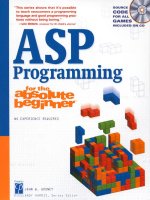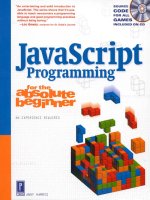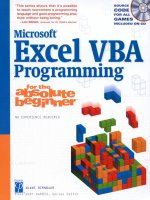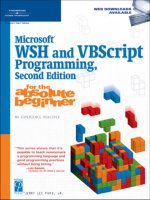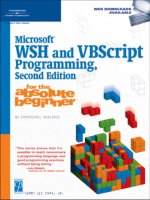C Programming for the Absolute Beginner phần 1 ppt
Bạn đang xem bản rút gọn của tài liệu. Xem và tải ngay bản đầy đủ của tài liệu tại đây (14.99 MB, 40 trang )
C Programming
for the Absolute
Beginner,
Second Edition
MICHAEL VINE
© 2008 Thomson Course Technol
ogy, a division of Thomson Learning
Inc. All rights reserved. No part of this book may be reproduced or trans-
mitted in any form or by any means, electronic or mechanical, including
photocopying, recording, or by any information storage or retrieval sys-
tem without written permission from Thomson Course Technology PTR,
except for the inclusion of brief quotations in a review.
The Thomson Course Technology PTR logo and related trade dress are
trademarks of Thomson Course Technology, a division of Thomson
Learning Inc., and may not be used without written permission.
All trademarks are the property of their respective owners.
Important: Thomson Course Technology PTR cannot provide software
support. Please contact the appropriate software manufacturer’s tech-
nical support line or Web site for assistance.
Thomson Course Technology PTR and the author have attempted
throughout this book to distinguish proprietary trademarks from
descriptive terms by following the capitalization style used by the
manufacturer.
Information contained in this book has been obtained by Thomson
Course Technology PTR from sources believed to be reliable. However,
because of the possibility of human or mechanical error by our sources,
Thomson Course Technology PTR, or others, the Publisher does not
guarantee the accuracy, adequacy, or completeness of any information
and is not responsible for any errors or omissions or the results obtained
from use of such information. Readers should be particularly aware of
the fact that the Internet is an ever-changing entity. Some facts may have
changed since this book went to press.
Educational facilities, companies, and organizations interested in mul-
tiple copies or licensing of this book should contact the Publisher for
quantity discount information. Training manuals, CD-ROMs, and por-
tions of this book are also available individually or can be tailored for
specific needs.
ISBN-10: 1-59863-480-1
ISBN-13: 978-1-59863-480-8
Library of Congress Catalog Card Number: 2007935959
Printed in the United States of America
08 09 10 11 12 TW 10 9 8 7 6 5 4 3 2 1
Publisher and General
Manager, Thomson Course
Technology PTR:
Stacy L. Hiquet
A
ssociate Director of
Marketing:
Sarah O’Donnell
Manager of Editorial
Services:
Heather Talbot
Marketing Manager:
Mark Hughes
Acquisitions Editor:
Mitzi Koontz
Project Editor:
Jenny Davidson
Technical Reviewer:
Greg Perry
PTR Editorial Services
Coordinator:
Erin Johnson
Copy Editor:
Heather Urschel
Interior Layout Tech:
Cover Designer:
Mike Tanamachi
Indexer:
Kevin Broccoli
Proofreader:
Sandi Wilson
Th
omson Course Technol
ogy PTR,
a division of Thomson Learning Inc.
25 Thomson Place
Boston, MA 02210
Val
ue-Chain Intl.
eISBN-10: 1-59863-634-0
To my son, Spencer—Go Bruins!
ACKNOWLEDGMENTS
riting a book is not easy, especially a technical programming book. It takes
many great, patient, and talented people to write, edit, design, market,
finance, and produce a book. Without the assistance of Mitzi Koontz,
Jenny Davidson, and Heather Urschel, it would be impossible for me to share with
you my knowledge of programming in such a professional and fun manner. I
would also like to give special thanks to our technical editor, Greg Perry, who is a
true C expert. For two editions now, Greg has kept me honest and accurate in the
complicated and often misunderstood world of C programming. Thanks, Greg!
W
ABOUT THE AUTHOR
ichael Vine
has taught computer programming, web design, and database
classes at Indiana University/Purdue University in Indianapolis, IN, and at
MTI College of Business and Technology in Sacramento, CA. Michael has
over 13 years’ experience in the information technology profession. He currently
works full-time in a Fortune 100 company as an IT Project Manager overseeing the
development of enterprise data warehouses.
M
This page intentionally left blank
Table of Contents
Getting Started with C Programming 1
Chapter 1
Installing and Configuring the Cygwin Environment 2
main() Function 4
Comments 7
Keywords 8
Program Statements 9
Escape Sequence \n 11
Escape Sequence \t 12
Escape Sequence \r 12
Escape Sequence \\ 13
Escape Sequence \” 14
Escape Sequence \’ 14
Directives 15
gcc Compiler 15
How to Debug C Programs 17
Common Error #1: Missing Program Block Identifiers 20
Common Error #2: Missing Statement Terminators 21
Common Error #3: Invalid Preprocessor Directives 21
Common Error #4: Invalid Escape Sequences 22
Common Error #5: Invalid Comment Blocks 23
Summary 24
Challenges 25
Primary Data Types 27
Chapter 2
Memory Concepts 28
Data Types 29
Integers 29
Floating-Point Numbers 29
Characters 30
Initializing Variables and the Assignment Operator 31
Printing Variable Contents 32
Conversion Specifiers 33
Displaying Integer Data Types with printf() 34
Displaying Floating-Point Data Types with printf() 34
Displaying Character Data Types with printf() 35
Constants 36
Programming Conventions and Styles 37
White Space 37
Variable Naming Conventions 38
Identifying Data Types with a Prefix 39
Using Uppercase and Lowercase Letters Appropriately 40
Give Variables Meaningful Names 41
scanf() 41
Arithmetic in C 43
Operator Precedence 45
Chapter Program–Profit Wiz 46
Summary 47
Challenges 48
Conditions 49
Chapter 3
Algorithms for Conditions 50
Expressions and Conditional Operators 50
Pseudo Code 50
Flowcharts 53
Simple if Structures 56
Nested if Structures 59
Introduction to Boolean Algebra 62
and Operator 62
or Operator 63
not Operator 63
Order of Operations 64
Building Compound Conditions with Boolean Operators 65
Compound if Structures and Input Validation 66
&& Operator 66
|| Operator 66
Checking for Upper- and Lowercase 67
Checking for a Range of Values 68
isdigit() Function 69
The switch Structure 71
Random Numbers 74
Chapter Program–Fortune Cookie 76
Summary 78
Challenges 79
C Programming for the Absolute Beginner, Second Edition
viii
Looping Structures 81
Chapter 4
Pseudo Code for Looping Structures 82
Flowcharts for Looping Structures 84
Operators Continued 88
++ Operator 88
Operator 91
+= Operator 92
-= Operator 94
The while Loop 95
The do while Loop 98
The for Loop 99
break and continue Statements 102
System Calls 104
Chapter Program–Concentration 105
Summary 107
Challenges 108
Structured Programming 109
Chapter 5
Introduction to Structured Programming 109
Top-Down Design 110
Code Reusability 112
Information Hiding 113
Function Prototypes 114
Function Definitions 116
Function Calls 119
Variable Scope 122
Local Scope 122
Global Scope 124
Chapter Program–Trivia 125
Summary 129
Challenges 130
Arrays 131
Chapter 6
Introduction to Arrays 131
One-Dimensional Arrays 132
Creating One-Dimensional Arrays 133
Initializing One-Dimensional Arrays 133
Searching One-Dimensional Arrays 138
Two-Dimensional Arrays 140
Initializing Two-Dimensional Arrays 141
Searching Two-Dimensional 143
Contents
ix
Arrays
Chapter Program–Tic-Tac-Toe 145
Summary 150
Challenges 151
Pointers 153
Chapter 7
Pointer Fundamentals 154
Declaring and Initializing Pointer Variables 154
Printing Pointer Variable Contents 157
Functions and Pointers 159
Passing Arrays to Functions 164
The const Qualifier 168
Chapter Program–Cryptogram 171
Introduction to Encryption 171
Building the Cryptogram Program 173
Summary 176
Challenges 177
Strings 179
Chapter 8
Introduction to Strings 179
Reading and Printing Strings 183
String Arrays 184
Converting Strings to Numbers 186
Manipulating Strings 189
strlen() 190
tolower() and toupper() 190
strcpy() 192
strcat() 193
Analyzing Strings 194
strcmp() 195
strstr() 196
Chapter Program–Word Find 198
Summary 200
Challenges 201
Introduction to Data Structures 203
Chapter 9
Structures 203
struct 204
typedef 206
Arrays of Structures 208
Passing Structures to Functions 210
C Programming for the Absolute Beginner, Second Edition
x
Passing Structures by Value 210
Passing Structures by Reference 212
Passing Arrays of Structures 214
Unions 217
Type Casting 219
Chapter Program–Card Shuffle 221
Summary 225
Challenges 226
Dynamic Memory Allocation 227
Chapter 10
Memory Concepts Continued 227
Stack and Heap 228
sizeof 229
malloc() 231
Managing Strings with malloc() 233
Freeing Memory 235
Working with Memory Segments 236
calloc() and realloc() 237
Chapter Program–Math Quiz 241
Summary 243
Challenges 245
File Input and Output 247
Chapter 11
Introduction to Data Files 247
Bits and Bytes 248
Fields, Records, and Files 249
File Streams 249
Opening and Closing Files 250
Reading Data 253
Writing Data 256
Appending Data 259
goto and Error Handling 262
Chapter Program–The Phone Book Program 265
Summary 268
Challenges 270
The C Preprocessor 271
Chapter 12
Introduction to the C Preprocessor 271
Symbolic Constants 272
Creating and Using Macros 275
Contents
xi
Building Larger Programs 278
Header File 279
Function Definition File 279
main() Function File 280
Pulling It all Together 281
Chapter Program–The Function Wizard 282
ch12_calculate.h 282
ch12_calculate.c 282
ch12_main.c 283
Summary 285
Challenges 285
What’s Next? 286
Common UNIX Commands 287
Appendix A
VIM Quick Guide 289
Appendix B
NANO Quick Guide 291
Appendix C
Common ASCII Character Codes 295
Appendix D
Common C Library Functions 299
Appendix E
Index 305
C Programming for the Absolute Beginner, Second Edition
xii
INTRODUCTION
is a powerful procedural-based programming language developed in 1972
by Dennis Ritchie within the halls of Bell Telephone Laboratories. The C
programming language was originally developed for use with the UNIX
platform and has since spread to many other systems and applications. C has in-
fluenced a number of other programming languages, including C++ and Java.
Beginning programmers, especially those enrolled in computer science and engi-
neering majors, need to build a solid foundation of operating systems, hardware,
and application development concepts. Numerous learning institutions accom-
plish this by teaching their students how to program in C so that they may progress
to advanced concepts and other languages built upon C.
Many students of C will rightly admit that it’s not an easy language to learn, but
fortunately Thomson Course Technology PTR’s Absolute Beginner series’ profes-
sional insight, clear explanations, examples, and pictures, make learning C easy
and fun. Each chapter contains programming challenges, a chapter review, and a
complete program that uses chapter-based concepts to construct an easily built
application.
To work through this book in its entirety, you should have access to a computer
with a C compiler such as gcc and at least one text editor like the ones found on
UNIX (e.g., vi, vim, Pico, nano, or Emacs) or Microsoft Windows (e.g., Notepad).
W
HAT
Y
OU
’
LL
F
IND IN
T
HIS
B
OOK
To learn how to program a computer, you must acquire a progression of skills. If
you have never programmed at all, you will probably find it easiest to go through
the chapters in order. Programming is not a skill you can learn by reading. You
have to write programs to learn. This book has been designed to make the process
reasonably painless and hopefully fun.
Each chapter begins with a brief introduction to chapter-based concepts. Once
inside the chapter, you’ll look at a series of programming concepts and small pro-
grams that illustrate each of the major points of the chapter. Finally, you’ll put
these concepts together to build a complete program at the end of the chapter. All
of the programs are short enough that you can type them in yourself (which is a
C
great way to look closely at code), but they are also available via the publisher’s website
(www.courseptr.com/downloads). Located at the end of every chapter is a summary that out-
lines key concepts learned. Use the summaries to refresh your memory on important con-
cepts. In addition to summaries, each chapter contains programming challenges that will
help you learn and cement chapter-based concepts.
Throughout the book, I’ll throw in a few other tidbits, notably the following:
These are good ideas that experienced programmers like to pass on.
These are areas where it’s easy to make a mistake.
Sidebar
As you examine concepts in this book, I’ll show you how the concepts are used beyond beginning
programming or in the real world.
W
HO
T
HIS
B
OOK
I
S
F
OR
This book was designed with the absolute beginner in mind. This book is not for experienced
C programmers wanting to learn object-oriented programming (OOP) with C++ or advanced
C data structures, such as linked lists.
This book is for you if:
• You’re a college or high school student studying beginning programming with C.
• You’re an experienced programmer in other high-level languages, such as Visual Basic,
VBA, HTML, or JavaScript, and you are looking to add C to your repertoire.
• You’re a programming hobbyist/enthusiast looking to learn C on your own.
• You’re interested in learning C++, C#, or Java and you were told to learn C first.
• You’ve always wanted to learn how to program and have chosen C as your first language.
TIP
CAUTION
C Programming for the Absolute Beginner, Second Edition
xiv
If you fall into any of the preceding categories, I’m sure you will enjoy this book’s
non-intimidating approach to programming in C. Specifically, I will teach you the basics of
C programming using non-graphical text editors and the ANSI C compiler gcc. You will learn
fundamental programming concepts such as variables, conditions, loops, arrays, structures,
and file I/O that can be useful in learning any programming language. Of course, you will
also learn some C-specific topics such as pointers and dynamic memory allocation, which
make the C language unique and oh so powerful.
Introduction
xv
This page intentionally left blank
1
C HAP TE R
GETTING STARTED WITH C
P
ROGRAMMING
elcome to C Programming for the Absolute Beginner, Second Edition! Whether
you’re a computer technology student, self-taught programmer, or sea-
soned software engineer, you should consider C an essential building block
to your programming foundation. After learning C you will have a broader under-
standing of operating system concepts, memory management, and other high-
level programming languages.
Throughout this book I will guide you through a series of examples designed to
teach you the basics of C programming. I assume you have no prior experience
with C programming or beginning computer science concepts. There are no pre-
requisites for this book (including advanced math concepts), although I will
assume you already have a basic understanding of at least one Microsoft or UNIX-
based operating system and text editor.
If you already have some prior programming experience with other languages,
such as Java, Visual Basic, PowerBuilder, or COBOL, you will still benefit from this
book. I hope after reading C Programming for the Absolute Beginner, Second Edition you
will continue to find this text a useful C programming reference.
W
I will cover the following topics in this chapter:
• Installing and configuring the Cygwin environment
•
main() function
• Keywords
• Comments
• Program statements
• Directives
• gcc compiler
• How to debug C programs
I
NSTALLING AND
C
ONFIGURING THE
C
YGWIN
E
NVIRONMENT
The minimum requirements for learning how to program in C are access to a computer, a
text editor, C libraries, and a C compiler. Throughout this book I will use a simple text editor
to write C programs. Unlike many high-level programming languages (think Visual Basic or
C#), the C language doesn’t require a high-end graphical user interface, which in my opinion
gets in the way of beginners who want to learn programming. For example, the beginning
programmer is so busy messing with a graphical user interface’s command buttons and tool-
boxes that the concept of a variable or loop becomes secondary, whereas those concepts
should be the PRIMARY concern for the beginning programmer.
There are a number of free C compilers and text editors that you can use and, of course, there
are many more that cost money. If you already have access to these tools, you can skip this
installation section. But if not, my friends at Cygwin have cleverly developed a simple,
yet robust Linux-like environment for Win-tel (Microsoft Windows–Intel) platforms that
includes many free software packages, such as a C compiler called gcc, text editors, and other
common utilities. You can download Cygwin’s free software components from their website
at .
The Cygwin setup process is very easy, but if you have questions or issues you can visit the
online user guide via Once installed,
you will have access to many UNIX-based utilities that can be accessed via a UNIX shell or the
Windows command prompt.
A minimum of 400MB of free hard drive space is required for installation (more or less
depending on the components selected). To install Cygwin and its associated components,
download the setup file from the aforementioned website or run the setup file directly from
Cygwin’s website ( Follow the setup screens until you get
2
C Programming for the Absolute Beginner, Second Edition
to the Cygwin Setup – Select Packages window, from which you can select the components
you want to install. As of this writing, the default components selected plus the “gcc-core:
C Compiler” installation component will be enough to follow this book in its entirety. Note
that the gcc-core: C Compiler component is not selected by default. To select this component,
click the plus sign (+) next to the Devel category and scroll down until you find the gcc-core:
C Compiler component. Click the word “skip” to select the component for installation.
If you want to select a component not already selected by default, click the word
“skip” in the Select Packages installation window to select a Cygwin component
to install.
After successfully installing the Cygwin environment, you will have access to a simulated
UNIX operating system through a UNIX shell. To start the UNIX shell, simply find the Cygwin
shortcut located on the desktop or through the program group found in the Start menu.
After starting the program, the Cygwin UNIX shell should resemble Figure 1.1
FIGURE 1.1
Launching the
Cygwin UNIX
shell.
Note the syntax used for the UNIX command prompt in Figure 1.1—yours will differ slightly.
Administrator@MVINE ~
$
The first line shows that you are logged into the UNIX shell as Administrator (default login
name) at your computer (
MVINE is the name of my PC). The next line starts with a dollar sign
(
$). This is the UNIX command prompt from where you will execute UNIX commands.
Depending on your specific installation (Cygwin version) and configuration (components
selected) of Cygwin, you may need to have Cygwin’s
bin directory, referenced next, added to
your system’s
PATH environment variable.
TIP
Chapter 1 • Getting Started with C Programming
3
c:\cygwin\bin
The PATH environment variable is used by Cygwin to find executable files to run. If you are
using a Microsoft-based operating system, you can edit the
PATH variable in a couple of ways.
One trick is to launch a Microsoft-based command shell (DOS window) by typing the keyword
cmd from the Run dialog box accessed via the Start menu. From the c:\ prompt (in the com-
mand shell), type:
PATH %PATH%;c:\cygwin\bin
This command appends c:\cygwin\bin to the end of the current PATH variable without over-
writing it. To verify the command was successful, simply type the keyword
PATH from the same
Microsoft-based command shell window. Note that a semicolon separates each distinct direc-
tory structure in the
PATH’s value. If necessary, consult your system’s documentation for more
information on environment variables and specifically updating the
PATH system variable.
main() F
UNCTION
In this section, I’ll start with the beginning of every C program, the main() function. Let’s first,
however, talk philosophically about what a function is. From a programming perspective,
functions allow you to group a logical series of activities, or program statements, under one name.
For example, suppose I want to create a function called
bakeCake. My algorithm for baking a
cake might look like this:
Mix wet ingredients in mixing bowl
Combine dry ingredients
Spoon batter into greased baking pan
Bake cake at 350 degrees for 30 minutes
Anyone reading my code will see my function called
bakeCake and know right away that I’m
trying to bake cakes.
Functions are typically not static, meaning they are living and breathing entities, again
philosophically, that take in and pass back information. Thus, my
bakeCake function would
take in a list of ingredients to bake (called parameters) and return back a finished cake (called
a value).
4
C Programming for the Absolute Beginner, Second Edition
Algorithms
An
algorithm
is a finite step-by-step process for solving a problem. It can be as simple as a
recipe to bake a cake, or as complicated as the process to implement an autopilot system for
a 747 jumbo jet.
Algorithms generally start off with a problem statement. It is this problem statement that
programmers use to formulate the process for solving the problem. Keep in mind that the
process of building algorithms and algorithm analysis occurs before any program code has
been written.
The main() function is like any other programming function in that it groups like activities
and can take in parameters (information) and pass back values (again, information). What
makes the
main() function unique from other functions, however, is that the values it returns
are returned to the operating system. Other functions that you will use and create in this
book return values back to the calling C statement inside the
main() function.
In this book, I will use
main() functions that are void of parameters (functions that do not
take parameters) and do not return values.
main()
{
}
As the preceding example shows, the main() function begins with the keyword main and is
followed by two empty parentheses
(). The parentheses are used to encompass parameters to
be passed to the
main() function.
C is a case-sensitive programming language. For example, the function names
main(), Main(), and MAIN() are not the same. It takes extra computing resources
to NOT be case-sensitive as input devices such as keyboards distinguish
between cases.
Following the parentheses are two braces. The first brace denotes the beginning of a logical
programming block and the last brace denotes the end of a logical programming block. Each
function implementation requires that you use a beginning brace,
{, and a closing brace, }.
The following program code demonstrates a complete, simple C program. From this code,
you will learn how single program statements come together to form a complete C program.
CAUTION
Chapter 1 • Getting Started with C Programming
5
/* C Programming for the Absolute Beginner */
//by Michael Vine
#include <stdio.h>
main()
{
printf("\nC you later\n");
}
When the preceding program is compiled and run, it outputs the text “C you later” to the
computer screen, as shown in Figure 1.2.
FIGURE 1.2
C program with
standard output.
Review the sample program code in Figure 1.3; you can see the many components that com-
prise a small C program.
FIGURE 1.3
Building blocks of
a simple C
program.
preprocessor
directive
main function
begin logical
program block
end logical
program block
printf function escape sequence
program statement
multi-line comment block
single line comment block
program statement terminator
6
C Programming for the Absolute Beginner, Second Edition
standard input output library
The remainder of this chapter will cover these components and how each is used to build a
simple C program.
C
OMMENTS
Comments are an integral part of program code in any programming language. Comments
help to identify program purpose and explain complex routines. They can be valuable to you
as the programmer and to other programmers looking at your code.
In the following line of code, the text
C Programming for the Absolute Beginner is ignored by
the compiler because it is surrounded with the character sets
/* and */.
/* C Programming for the Absolute Beginner */
The character set /* signifies the beginning of a comment block; the character set */ identifies
the end of a comment block. These character sets are not required to be on the same line and
can be used to create both single-line and multi-line comments. To demonstrate, the following
block of code shows the usefulness of multi-line commenting.
/* C Programming for the Absolute Beginner
Chapter 1 – Getting Started with C Programming
By Michael Vine
*/
Your C program may not compile correctly if you leave one of the comment character sets
out or if you reverse the characters. For example, the following code segment leaves out a
comment character set and will not compile.
/* C Programming for the Absolute Beginner
The next line of code also will not compile because comment character sets have been incor-
rectly ordered.
*/ C Programming for the Absolute Beginner */
You can also create quick one-line comments with the character set //. The next line of code
demonstrates this.
//by Michael Vine
If your C compiler supports C++, which gcc does, you can use the single line //
character set for one-line commenting. Though unlikely, be aware that not all C
compilers support the single line character set.
CAUTION
Chapter 1 • Getting Started with C Programming
7
Any characters read after the character set // are ignored by the compiler for that line only.
To create a multi-line comment block with character set
//, you will need the comment
characters in front of each line. For example, the following code creates a multi-line
comment block.
//C Programming for the Absolute Beginner
//Chapter 1 - Getting Started with C Programming
//By Michael Vine
K
EYWORDS
There are 32 words defined as keywords in the standard ANSI C programming language. These
keywords have predefined uses and cannot be used for any other purpose in a C program.
These keywords are used by the compiler, in this case gcc, as an aid to building the program.
Note that these keywords must always be written in lowercase (see Table 1.1).
T
ABLE
1.1 C L
ANGUAGE
K
EYWORDS
Keyword Description
auto
Defines a local variable as having a local lifetime
break
Passes control out of the programming construct
case
Branch control
char
Basic data type
const
Unmodifiable value
continue
Passes control to loop’s beginning
default
Branch control
do
Do While loop
double
Floating-point data type
else
Conditional statement
enum
Defines a group of constants of type int
extern
Indicates an identifier as defined elsewhere
float
Floating-point data type
for
For loop
goto
Transfers program control unconditionally
if
Conditional statement
int
Basic data type
long
Type modifier
register
Stores the declared variable in a CPU regist
er
8
C Programming for the Absolute Beginner, Second Edition

